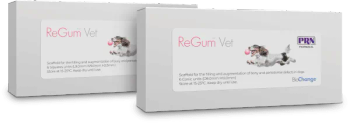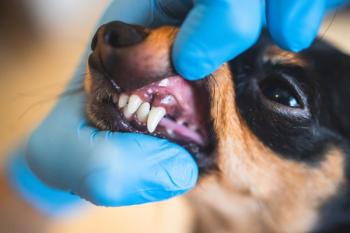
Defining dental malocclusions in dogs
When teeth don't line up correctly, pain and further dental problems are likely.
Dogs deserve the same straight, engaging smile we humans seek, right? OK, that may be stretching it a bit, but what our patients do deserve is a bite that's comfortable. This article highlights the classes of malocclusion. Future articles in this series will address individual cases that fall into these classes and show what can be done using both common and uncommon techniques to resolve problems.
Identifying and preventing problems
As opposed to normal occlusion (Photos 1-3), malocclusions involving teeth abnormally contacting other teeth or soft tissue can result in discomfort and pain. It's easy to overlook occlusal problems, since the lips and cheeks can block direct view of the teeth. A thorough oral examination starting with the initial puppy visit can identify important abnormalities that may require immediate attention. Failure to recognize problems and treat them early with simple extractions may result in permanent teeth malocclusions that require extensive extractions or multiple-procedure orthodontics.
Photo 1:
Normal occlusion of the incisors in a dog.Although preventing permanent teeth malocclusions is ideal, most of the cases veterinary dentists encounter consist of traumatic tooth-on-tooth or tooth-on-tissue disease in an adult patient that might otherwise have been prevented. Many patients present with severe tooth wear, fractures, endodontic disease and trauma to the palatal and lingual floor soft tissue or bone. So knowing normal anatomy is the first step in recognizing abnormal occlusions that can progress to more serious disease.
Photo 2:
Normal occlusion of the canines in a dog.
Types of malocclusions
The American Veterinary Dental College (AVDC; www.avdc.org) describes dental malocclusions as follows:
• Distoversion:
A tooth that's in its anatomically correct position in the dental arch but is abnormally angled in a distal direction.
• Mesioversion:
A tooth that's in its anatomically correct position in the dental arch but is abnormally angled in a mesial direction.
• Linguoversion:
A tooth that's in its anatomically correct position in the dental arch but is abnormally angled in a lingual direction.
• Labioversion:
An incisor or canine tooth that's in its anatomically correct position in the dental arch but abnormally angled in a labial direction.
• Buccoversion:
A premolar or molar that's in its anatomically correct position in the dental arch but is abnormally angled in a buccal direction.
• Crossbite:
A malocclusion in which a mandibular tooth or teeth have a more buccal or labial position than the antagonist maxillary tooth. It can be classified as rostral or caudal. In rostral crossbite cases (similar to anterior crossbite in people), one or more of the mandibular incisor teeth are labial to the opposing maxillary incisor teeth when the mouth is closed. And in caudal crossbite cases (similar to posterior crossbite in people), one or more of the mandibular cheek teeth are buccal to the opposing maxillary cheek teeth when the mouth is closed.
Photo 3:
Normal occlusion of the premolars in a dog.
Symmetrical malocclusions
Three classes of symmetrical malocclusions occur in dogs.
• Neutroclusion
(Class 1 malocclusion; MAL/1): Jaw lengths are normal, but one or more teeth are in an abnormal position (Photo 4). Examples include lance canine, rostral crossbite, caudal crossbite and level bite.
• Mandibular distoclusion
(Class 2 malocclusion; MAL/2): The mandible resides distal (caudal) to its normal location in relation to the maxilla (Photo 5). This often results in mandibular canine teeth traumatizing the palate.
• Mandibular mesioclusion
(Class 3 malocclusion; MAL/3): The mandible resides mesial (rostral) to its normal location in relation to the maxilla (Photo 6). Although considered normal in brachycephalic breeds, maxillary incisor contact with the lingual floor or canine teeth can cause significant trauma and discomfort. .
Photo 4:
A class 1 malocclusion.
Photo 5:
A class 2 malocclusion.
Photo 6:
A class 3 malocclusion.
Asymmetrical malocclusions
According to AVDC, maxillary-mandibular asymmetry describes skeletal malocclusions that can occur in one of the following directions:
•
Rostrocaudal:
A MAL/2 or MAL/3 malocclusion is present on one side of the face while the contralateral side retains normal dental alignment.
•
Side-to-side:
Loss of the midline alignment of the maxilla and mandible.
•
Dorsoventral:
Results in an open bite, defined as an abnormal vertical space between opposing dental arches when the mouth is closed.
Wry bite
is a nonspecific layman's term used to describe various unilateral occlusal abnormalities, so its use isn't recommended.
Conclusion
As you can see, many malocclusions affect canine patients. As long as there is tooth or tissue trauma involved, therapy is likely indicated. In the next several issues, I'll discuss common malocclusions in each class and describe the appropriate techniques and methods employed for their resolution.
Dr. Beckman is acting president of the American Veterinary Dental Society and owns and operates a companion-animal and referral dentistry and oral surgery practice in Punta Gorda, Fla. He sees referrals at Affiliated Veterinary Specialists in Orlando and at Georgia Veterinary Specialists in Atlanta, lectures internationally and operates the Veterinary Dental Education Center in Punta Gorda.
Newsletter
From exam room tips to practice management insights, get trusted veterinary news delivered straight to your inbox—subscribe to dvm360.






